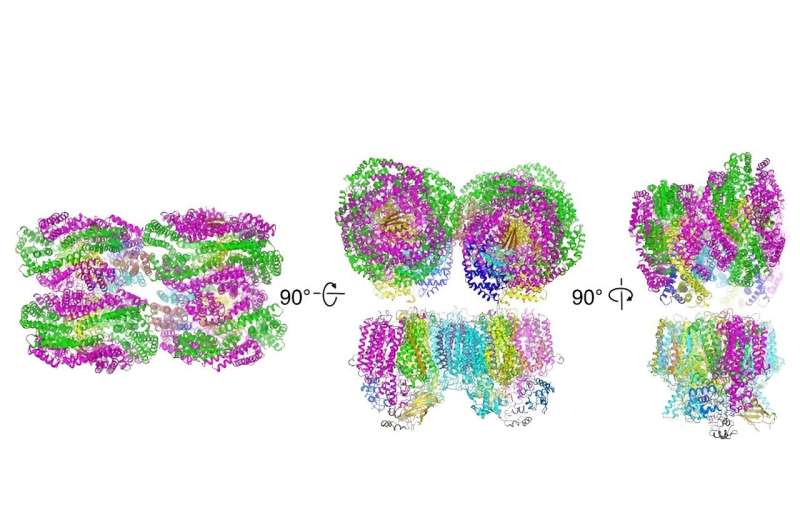This article has been reviewed according to Science X's editorial process and policies. Editors have highlighted the following attributes while ensuring the content's credibility:
fact-checked
peer-reviewed publication
trusted source
proofread
Altered light-harvesting complex in a cyanobacterium allows low-energy light use

Researchers have isolated and determined the molecular structure of the light-harvesting antenna that helps some cyanobacteria—formerly referred to as blue-green algae—produce energy through photosynthesis even in lower-energy light.
The structure was the only component of the photosynthesis-enabling apparatus used when the cyanobacteria acclimate to using far-red light, which is just outside of the visible spectrum, not yet mapped by researchers.
Eventually, understanding the structures of these components acclimated to photosynthesizing energy from such low light could inform efforts to engineer shade-tolerant crop plants, according to the researchers.
"In modern agriculture, crops like corn and soybeans are planted in high-density arrays that preclude direct access to sunlight by all but the top-most leaves of the canopy," said Donald A. Bryant, Academy Professor, Ernest C. Pollard Professor Emeritus of Biotechnology, and professor emeritus of biochemistry and of molecular biology in the Eberly College of Science at Penn State, and leader of the research team. "Expanding the usable solar spectrum for such crops would have many direct benefits to crop productivity."
A paper describing the structure, which was chosen as an "Editor's Pick" by the journal, appears in the Journal of Biological Chemistry. The results, by a team led by a Penn State biochemist, represent the culmination of nearly a decade of research that has now determined the structure of all three major photosynthesis components in a cyanobacterium acclimated to far-red light.
These components comprise the photosynthetic apparatus, complex molecular machinery that can adapt to produce energy even when only lower-energy light is available.
"Like plants, cyanobacteria use photosynthesis to produce energy, and they can grow in a wide variety of environments, including some that are inhospitable to most other forms of life," Bryant said.
"They often grow in large colonies or laminated mats where only the top layer of cells is exposed to direct sunlight. Cells underneath only receive light that has already been filtered by the cells above them, but they still manage to produce energy through photosynthesis to survive. We have been interested in understanding the changes that occur in their photosynthetic apparatus that allow them to do this."
Most photosynthetic organisms use visible light, which spans from red to violet like in a rainbow. The wavelengths of visible light range from about 700 nanometers (nm) at the low-energy red, end to about 400 nm at the higher-energy violet end.
Wavelengths just above 700 are referred to as far-red light, before getting into the infrared at around 780 nm. Photosynthetic organisms collect this light using pigments, like chlorophyll, that are optimized to gather light in the visible range. In a thick mat of cyanobacteria, the cells near the surface filter out the visible light, leaving only scraps for the cells below.
"When we grow cyanobacteria in the lab under far-red light, mimicking the conditions of the cells at the bottom of a microbial mat, an alternative set of genes is activated that code for key components of the photosynthetic apparatus," Bryant said.
"We've been working to show exactly where these alternative components, as well as alternative forms of chlorophyll, are incorporated into the photosynthetic apparatus and how this allows the cyanobacteria to use far-red light."
In previous papers, the research team described the structure of two of the three major photosynthetic components, photosystem I and photosystem II, in far-red light acclimated cyanobacteria.
"This paper describes the third—and final—component of the photosynthetic apparatus that is produced in a cyanobacterium when it is grown in far-red light," Bryant said, explaining that they used high-resolution cryo-electron microscopy to determine the final component, called the antenna complex or phycobilisome.
"So, we now have structures for the whole shebang. I am the type of guy that likes to see the last square filled in when I do a crossword puzzle, so this paper marks a milestone."
With the three completed structures, the researchers now know exactly which parts of the photosynthetic apparatus are altered and where alternative forms of chlorophyll attuned to absorb far-red light are incorporated.
They are beginning to piece together how the three components interact to allow the cyanobacteria to perform photosynthesis using far-red light.
More information: Christopher J. Gisriel et al, Structure of the antenna complex expressed during far-red light photoacclimation in Synechococcus sp. PCC 7335, Journal of Biological Chemistry (2023). DOI: 10.1016/j.jbc.2023.105590
Journal information: Journal of Biological Chemistry
Provided by Pennsylvania State University





















